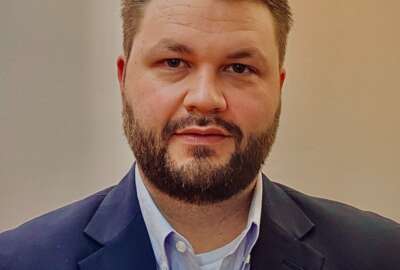Hubbard Radio Washington DC, LLC. All rights reserved. This website is not intended for users located within the European Economic Area.
ISS Laboratory looking to spark more in-space production with grant opportunity
The ISS National Lab recently announced a new funding opportunity for in-space production applications.
Beginning today with the ISS National Lab. It’s the government funded organization which manages all non-NASA research and investigations. It recently announced a new funding opportunity for in-space production applications, which can leverage the unique space environment to develop, test, or mature new products and processes. To find out more about the potential here and it’s role overall in U.S. space research, I got the chance to speak with Ryan Reeves, who is a material scientist with the ISS National Lab.
Interview Transcript:
Ryan Reeves The ISOs National Lab was created by Congressional Act in 2005. The purpose of that was to open up the opportunities to the access to the International Space Station, for applications and for research beyond those that that NASA was pursuing at the time, so that any U.S. based person and company could access the unique facility that is the International Space Station. So, we took over managing the national lab in 2011. And largely what we do is reach out to industry, to academia, looking for researchers that could use the microgravity environment, the space environment, to test out some of their ideas, some of their research and technologies and, and really kind of push those technologies forward.
Eric White And so I imagine this helps speed up the process a little bit, maybe, you know, rather than having to go through a lot of the bureaucracy that would be required if they wanted to work straight with NASA. This may be a little bit of a way to streamline them, just so that folks can get up there and get to work.
Ryan Reeves Right? Yeah. And, you know, I’d like to say that that we’re a super streamlined organization and everything is going to come in and fly right away. You know, in the early days of our, of our history, we have 50% of the allocations or 50% of the research that goes up to the International Space Station is from the National Lab. You know, in those early days, the there was more allocation than there were projects to fly. Now we’re in the, the reverse where, you know, we have a lot of really good ideas, a lot of things coming in. But yeah, the idea is, is now we have specific calls out, national lab research announcements or NLRAs, as we call them, so that this offers an opportunity, a pathway by which people can, can seek to prove out their technologies to in some cases, you know, where you’re a lot further advanced on your technology readiness levels. You’re able to conduct that in a relevant space environment and now be able to say that you have flight validated hardware. So that that’s been really useful for a number of companies.
Eric White It can give me just a couple of examples off the top of your head of some of the developments that have been made using research and development tactics, actually on the station.
Ryan Reeves Yeah. So, you know, one example is, from the pharmaceutical industry. So, Merck sent up one of their cancer drugs, a, Keytruda. And so, what they were looking for was to see if the crystallization happened in a different manner, if they could get different structure, different properties from that. What they saw was that the crystal structure was, and the crystals in general were a lot more, uniform. They were smaller overall, but they were a lot more uniform. And as a result, that led to potentially being able to use these as opposed to being having to be conducted in an IV drip and have more lifetime limitations. Now, they could be injected intravenously, and so the handling of them was a lot easier from a patient perspective. Now, you might be able to spend less time at the doctor’s office, you know, in those sorts of treatments. Other examples of that includes, you know, more on the technology development side. We had Orbital Sidekick sent up a hyperspectral camera. So, this is a camera that’s able to be viewed and, you know, the infrared, the visible region, the far infrared, you know, many different regions. And they were looking to target customers that might be looking for gas pipeline leaks or, you know, rare mineral earth deposits, things of that nature. So, they proved out the technology by operating on the O source. And since then, they’ve had a number of customers that they’ve been able to sell their products to and have, included these, these satellite, imaging technologies for Earth observation. Since then, one more example of one of those is Orbit Fab. And so, there’s a number of satellites that are up in orbit, and they have a limited lifetime, mostly because of the fuel limitations. Once they’ve kind of consumed their fuel and, you know, they’re not able to make maneuvers within orbit to reposition, they kind of outlived their usefulness in that regard. So, one of the biggest ways that we can prolong the life of that is if there was a refueling opportunity. So, Orbit Fab did a series of tests with us on the International Space Station using a special autonomous robot on the ISS called Astrobee. And they showed that they could use their technology to refuel when you don’t have, gravity to automatically kind of drain out the fuel from one side to another. And just recently, I saw that they had shipped out many of their, their nodes for refueling to a number of customers. So once those are eventually launched in orbit, and orbit five is able to get their operation up and going, there will be ports that they can go into and refuel those satellites.
Eric White Very cool. So, in this new initiative that you all have, again, it’s a new funding opportunity to sort of further in space production. Can you kind of define that for me? Because it’s kind of a buzzword that I’ve heard from many of my other interviews. And, you know, it seems as if it’s something that might be more pronounced further down the road. But right now, is it in its beginning phases and what exactly is going on with in in space production?
Ryan Reeves Right. So, you know, this has been a goal for of NASA. But, you know, all around the world, all space agencies, as soon as we started putting up humans into space and we started sending research, the goal was there must be something that we could produce so uniquely, in space are of such quality that, we could bring it back down to Earth and it would change various industries. And so this goes back to Skylab, it goes back to the Mir space station’s, you know, going all the way back, the first kind of product that was potentially produced in space, that was brought back and then sold on Earth, arguably there, NASA worked with NIST to produce space beads. These were poly, polymer beads that were of, very uniform, sphere like construction. Right. The sphericity of them, or the uniformity of that was so high that they could use those as calibration standards. So, in the 1983 time period, they produced a bunch of them and then NIST sold them on their website. Since then, there’s been kind of a gap in terms of products that were produced in space and then brought back down here on Earth. But we’ve seen through the research that’s been done on the International Space Station over the last 20 years, that there are a number of technologies which seem ripe for that opportunity. So, one of those is an exotic optical fiber, we call it Z blend that stands for the chemical elements in there. But these Z blend optical fibers have the potential to have orders of magnitude less losses than, traditional silicon optical fibers. But when we draw them on Earth, because of those, chemical elements have very different densities, they start to separate out and they get form these crystals, which interferes with that optical transmission. What they showed NASA, did a series of studies in the 90s that showed that if you are able to draw these fibers in space, or at least in a microgravity environment, that you could eliminate that crystallinity and potentially get much better, quality from that. So, one of the things that we have seen, the first commercial attempt at drawing fibers in microgravity occurred on the ISS. We sponsored a payload and by which those were drawn in 2019. And since then, we’ve had at least four companies that have gone and tried to produce an optical fiber in in microgravity, the most recent being Flawless Photonics, which was able to do kilometers of draws of these fibers, which is much higher than we have seen in the past.
Eric White Okay. And so, with this new funding opportunity, are you all looking to further the advancements already made in producing certain products? Are you looking at potentially new kinds of products that could fit that mold? Because obviously we don’t have any no zero gravity environments down here that I’m aware of. So, you don’t really know until you try. Or do they already know before they try?
Ryan Reeves Yeah. So, I mean, certainly we would want to see some evidence that shows why you think that there, you know, that microgravity would improve the, the quality or the, or the structures, something about the material. But no, it doesn’t have to be something that has already been tested. We realize that while we’ve been doing space research, you know, on the ISS for the past 20 years on, you know, going back much further than that, we are cognizant of the fact that there’s a lot more to discover and things that we haven’t even thought of, the opportunities that we foresee right now, you know, in kind of some of the preliminary data has been a lot in the area of crystallization. So that could be on the organic side with, protein crystals or, or drug crystal formation that could be on the inorganic side. So that could be things like, semiconductors or simulators for detectors. So, there are opportunities out there. We have things in additive manufacturing, whereby, you know, particularly on the biological side with soft materials, you’re able to produce materials with and tissues which don’t collapse under their own weight, but instead are allowed to mature and strengthen over time in the microgravity environment, so that when you bring them back down to Earth, they’re able to support their own weight. And you don’t, you they don’t collapse into a puddle. So, you know, the answer to, to your question was both. You know, there is a number of projects which have already proved out some potential, but we’re open to hearing new ones because we know that there, you know, that, that the new the next technology is still out there as well.
Eric White Understood. All right. And so, what is the potential here? Obviously, you know, we know that the ISS won’t be up there forever. NASA has already said that. Could we see a future where there are more stations up there just for the purpose of either studying or manufacturing these kinds of goods?
Ryan Reeves You know. Absolutely. And what? We’re already starting to see that now. So, NASA has funded a number of companies to continue on after the ISS. And so, these commercial Leo destinations, like, an Axiom Space, the orbital reef from Blue Origin and Sierra Space, one from Voyager, those are coming down the line. And, you know, their goal is to be up there before the ISS is decommissioned and are in and around 2030. But even outside of that, we’re already seeing Lavada, just sent up a capsule that was looking to produce crystals up in space for biomanufacturing. They just returned those samples and released some of the data. So, we’re already seeing opportunities whereby there’s more opportunities out there beyond just the ISS. And we expect that to grow even more in the future.
Eric White And what do you see the role of the National Laboratory once the ISS days are done, or do you continue to see yourself as a sort of liaison between the research and private sector and getting folks up to research in space?
Ryan Reeves Yeah. So right now, the ISS National Lab, our cooperative agreement is tied to the ISS itself. So, our goal here is to accelerate all of these technologies such that they’re able to bridge the gap when the ISS is decommissioned, and they can go and start doing business to business transactions. With all of these commercial space stations. They’re likely will be a need for some sort of entity to provide those that those functions whereby you’re helping to translate, you know, ground based science into what can be done on station, who that will be, will ultimately be up to NASA in terms of how they want to restructure that. But one of the things that I haven’t talked about yet that we’ve served a role in is, you know, we’ve been working with government agencies that don’t traditionally work in space. So, we worked with NIH in these tissue chips, looking at, different systems of tissues and how they interconnect in, in a microgravity environment where you start to see accelerated aging. We’ve also worked with NSF in two different calls, expanding over the course of nine years. So, I would think that some sort of entity, you know, post ISS still serving that role. That would make a lot of sense.
Eric White Yeah. Plus, you’d like to see your babies all grown up, right?
Ryan Reeves I mean, we’re happy with the progress that we’ve seen so far and we’re excited for the future of these technologies. So yes, we have solicitations that go on throughout the year. So, while this one’s focused on what sort of materials can we produce in space to be able to bring back down here and use on Earth? We also have an opportunity out there now for Stem education and workforce development. So, if you go to our website ISSNationallab.org, you’ll see all of the opportunities that we have out now, as well as the ones that we project out in the next year or so.
Copyright © 2024 Federal News Network. All rights reserved. This website is not intended for users located within the European Economic Area.
Eric White
Eric White is news anchor and Federal Drive producer at Federal News Network.
Follow @FEDERALNEWSCAST





